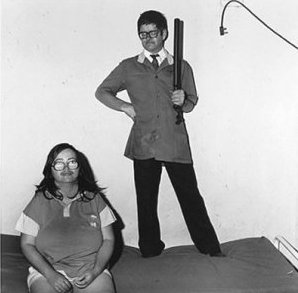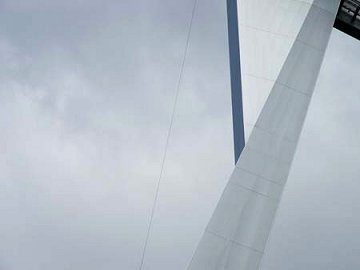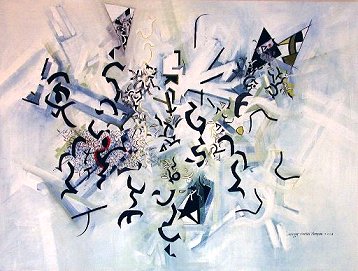ARTnews
Three Portland Reviews
Roger Ballen
Quality Pictures Contemporary Art
New York-born photographer Roger Ballen, a longtime expatriate living in South Africa, chronicled his progression from documentarian to auteur in this survey of work ranging from the early 1990s to the present. In vignettes that became chronologically more theatrical, Ballen superimposed a Fellini-like fascination with eccentric characters, animals, and props atop a Bergman-esque penchant for grim, existentialist backdrops. The untitled large-scale silver gelatin prints exuded luxuriant presence despite the sparsity, grittiness, and willful inscrutability of their subject matter.
A pronounced neo-Surrealist element rippled through the staged tableaux, as in an untitled work showing a man cradling a duck in his hands, a bent wire on the wall behind him, a toy tractor on the dirt-covered floor. Other photographs offered similarly bizarre scenes: a puppy chasing a mouse beneath a chalk drawing of a dog (Place of the Upside Down); duck heads and rat tails poking up from holes in the floor (Forsaken); a skeletally thin hand being bitten by a snake (Bite); and Animal Abstraction, with its rabbit, cat, oddly suspended wire mobile, and precarious three-legged table: a vertiginous scene-setting which obliquely recalls Philippe Halsman’s famous photo, Dalí Atomicus.
In the past, Ballen’s predilection for models with Coke-bottle spectacles, missing teeth, and tell-tale signs of retardation and mental illness have exposed him to charges of exploitation, and in works such as Security Guard and Girlfriend and Partytime, these charges—or at least the popular and critical soul-searching the controversy provoked—seemed not altogether without merit. As to Ballen’s blurring of vérité and staging, in this age of reality TV the distinction seemed moot. More relevant, the exhibition suggested, was the degree to which the works’ self-conscious envelope pushing buttressed or diminished their impact as depictions of squalor, madness, and the arcane.
—Richard Speer
1272007 by Jeff JahnZeitgeist: A Changing Landscape
Pulliam Deffenbaugh Gallery
The contemporary art culture in the Pacific Northwest has generated renewed interest in recent months, with Northwest artists spotlighted in the Art Video Lounge at the 2007 Art Basel Miami Beach, Portlander M.K. Guth’s inclusion in the Whitney Biennial, and the Portland Art Museum’s tightly focused Contemporary Northwest Art Awards (showing until Sept. 14). Pulliam Deffenbaugh’s Zeitgeist: A Changing Landscape aimed to explore the region’s most salient aesthetic commonalities via a group show of work recently completed by artists currently living in the Northwest or recently emigrated to other parts of the country. The show highlighted a dichotomy between artists working in traditional and contemporary modes of expression and theme, often centering around landscape and a feistily independent citizenry descended from frontier families and logger stock.
This division was most clearly visualized in a divide between representation and abstraction. In the former camp, Brian Borrello contributed paintings of semi-abstracted vegetal forms, channeling a concern for natural environment that has been part of the regional ethos since the days of Lewis and Clark. In a similar vein, Kay French painted flowers, grasses, stems, and leaves, and in a set of diminutive sculptural works glued paintings to the bottom of glass paperweights, capturing a still uneasy coexistence between pioneer craft traditions and a more cosmopolitan present. Ty Ennis’ simplistic drawing of a book of matches, Porn Booth Souvenir, betrays the Northwest penchant for understated lowbrow chic, a vein further explored in Daniel Peterson’s affectless photograph of a ramshackle loading dock in a Portland warehouse inhabited by DIY art squatters.
In his drawings, James Boulton worked to bridge the lowbrow/highbrow gap, merging whimsical depictions of kittens, yarn, cheerleaders, and checkerboards with shapes culled from Euclidean geometry, overlaid with grafitti. With their sprawling compositions and unlikely visual integrations, the works came across as winky Gen-Y pastiche. In his architectural photographs, Jeff Jahn eschewed easy readability in favor of a more formalist take. In particular, his 1272007, zeroing in on a detail of Portland’s iconic aerial tram, counterposed the city’s reputation for granola-crunching civic responsibility with a colder, neo-International aesthetic. Painter G. Lewis Clevenger took this tack yet another step in his Site, a chromatically invigorating etude on rectilinear abstraction based on blueprints for mid-Century ranch homes. As a whole, Zeitgeist reflected unified themes through disparate approaches, betraying the push-and-pull between reverence for a rich past and the incessant call of the future.
—Richard Speer
Margot Voorhies Thompson
Laura Russo Gallery
Harkening to the dovetailing lineages of calligraphy and grafitti, the work of Margot Voorhies Thompson deconstructs language into alphabet into gesture. In Inventing/Adapting, the artist deployed characters that appeared a wild hybrid of Hebrew, Arabic, Greek, and kanji, most notably in a series called Words in Motion. These mixed-media works on canvas centered around pictographic forms that danced down the picture plane while other forms flitted upwards like seagulls. In Words in Motion 2, rune-like figures hurtled forth willy-nilly from a central vanishing point. The resulting sense of dynamism was tempered by the rectangular planes behind and in front of the text, which seemingly floated forward and receded in a fashion reminiscent of director Peter Greenaway’s film The Pillow Book. In the drawings Motion and Motion II, Thompson incorporated cross-hatched and solid passages in syncopated compositions in the vein of constructivism.Not as successful were works that essayed geometric abstraction without the emphasis on letter forms. Interior, a large (10’x7’) handwoven silk rug, was only marginally affecting beyond its impressive scale, while small, collaged monotypes lacked the presence of the paintings on canvas. At their best, however, the components of the larger compositions hurtled forth from the picture plane with a propulsion and expansiveness similar to the elegant fantasias of Jose Parla. Like Parla, Thompson is adept at separating linguistic meaning from the physical contours of words. In Inventing/Adapting, she recontextualized those contours with exuberance and an inscrutability that demanded, then steadfastly refused, to be decoded.
—Richard Speer
BACK TO RICHARD'S ARTNEWS REVIEW MENU
BACK TO RICHARD'S WELCOME PAGE
BACK TO RICHARD'S RESUME


